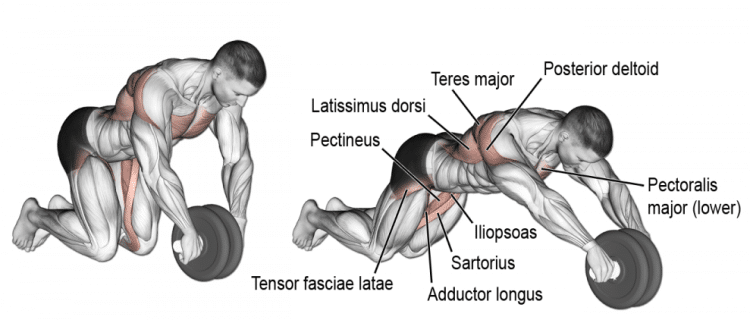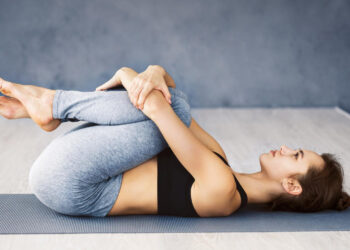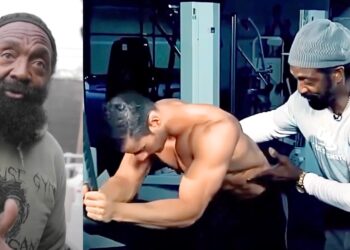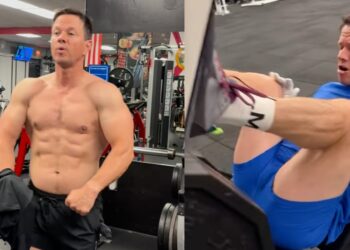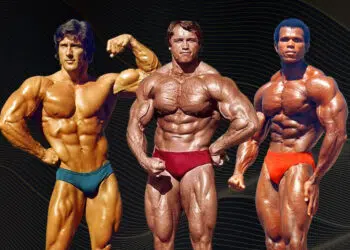While there is nothing particularly wrong with exercises like sit-ups, crunches, and planks, they’ll soon start to lose their potency as you get stronger. After just a short time, you’ll find yourself doing high rep sets to fatigue your core muscles.
This is not only a waste of time, but it also means your workout won’t be as effective as it could be.
After all, the best way to strengthen your muscles is to overload them. If more reps were all that was needed, long-distance runners would have massive, muscular legs, which they usually don’t.
One way to add some much-needed intensity to your abs workout is to start doing rollouts. This old-school move is much more demanding than most other bodyweight exercises, which is why it’s such a good choice for more advanced exercisers.
But, to do rollouts, you need an abs wheel. While abs wheels are pretty cheap, not everyone wants to buy one, and not all gyms have one for you to use.
The good news is that there are several ways to do rollouts without an abs wheel. Some of these exercises are almost identical to abs wheel rollouts, while others are similar enough that any differences don’t really matter.
Level Up Your Fitness: Join our 💪 strong community in Fitness Volt Newsletter. Get daily inspiration, expert-backed workouts, nutrition tips, the latest in strength sports, and the support you need to reach your goals. Subscribe for free!
So, here are the seven best ways to do rollouts even if you don’t have an abs wheel.
Wheel Rollout Muscles Worked
Before we reveal the best ways to do rollouts without an abs wheel, let’s take a quick look at the primary muscles involved in this excellent exercise…
Rectus abdominis – this is the muscle on the front of your abdomen, which is responsible for spinal flexion. When well-developed, and providing that you are lean enough, this is the muscle that forms your six-pack.
Obliques – there are two sets of obliques, internal and external, and they are responsible for rotation and lateral flexion of your spine. Basically your waist muscles, during rollouts, the obliques work isometrically or statically to stop your hips from twisting.
Transverse abdominis – this muscle is part of your inner abdominal unit, a group of muscles responsible for creating intra-abdominal pressure, or IAP for short. IAP helps stabilize your spine from within. The transverse abdominis works like a corset or weightlifting belt and, when it contracts, squeezes inward to compress your abdominal contents.
Pelvic floor – the muscle at the bottom of your inner unit. The pelvic floor helps support your pelvic organs and maintain intra-abdominal pressure.
Diaphragm – your main breathing muscle, the diaphragm contracts and flattens to seal the top of your inner unit.
Serratus anterior – the serratus anterior is a fan-shaped muscle that wraps around the outside of your upper ribs and attaches below your scapulae or shoulder blades. It looks a little like the teeth of a serrated knife blade, which is how it gets its name. It’s is responsible for the protraction of your shoulder girdle and helps keep your shoulder blades flat against your rib cage.
Iliopsoas – also known as your hip flexors, this muscle is made up of two individual parts; the iliacus and psoas major. However, because they always work together, they’re almost always referred to as the singular iliopsoas. This is one of the muscles used during the couch stretch.
Latissimus dorsi – while rollouts are mainly an abdominal and core exercise, the lats are also strongly involved. The arm action in rollouts is very similar to doing dumbbell or barbell pullovers.
7 Ways to Do Rollouts When You Don’t Have an Abs Wheel
No abs wheel? No problem. You can work your abs in much the same way with these wheel-less alternatives!
1. Barbell rollouts
Barbell rollouts aren’t just a good way to work your core without an abs wheel; they’re also an effective way to make this movement even more demanding. Using heavier weights means you have to work harder, and harder is always better when it comes to building muscle and strength.
How to do it:
- Load your barbell with two round, equally-sized weight plates. Secure the plates with collars, or they’ll probably roll off the ends of the bar.
- Place the bar on the floor and kneel behind it. Grip the bar with an overhand, shoulder-width grip. Pull your shoulders down and back and brace your abs.
- Maintaining core tension, roll your barbell along the floor and away from you. Extend your arms as far as you can without hyperextending your lumbar spine. Try to lower your chest and abdomen down to within a couple of inches of the floor. Your body should be straight, or very close to it, at the midpoint of your rep.
- Using your abs, lats, and hip flexors, pull the barbell back in toward your legs, lifting your body back up as you do so.
- Take a breath, reset your core, and repeat.
You can also do this exercise from standing, although that is much more demanding.
2. Stability ball rollouts
Level Up Your Fitness: Join our 💪 strong community in Fitness Volt Newsletter. Get daily inspiration, expert-backed workouts, nutrition tips, the latest in strength sports, and the support you need to reach your goals. Subscribe for free!
Most people are familiar with stability ball crunches, which are a very effective abs exercise. However, you can also use this core-training tool for rollouts. For this exercise, the smaller the ball, the harder the exercise will be. But, like all rollouts, you can do this exercise from your knees or standing as preferred.
How to do it:
- Kneel or stand behind your ball. Reach forward and place your hands on the ball. Brace your abs and pull your shoulders down and back.
- Roll the ball out and away from you, extending your hips as you go. Extend your arms as far as you can without hyperextending your lower back.
- Roll the ball back in, reset your core, and repeat.
3. Suspension trainer rollouts
Suspension trainers like the TRX are very versatile training tools. You can use them to make almost any bodyweight exercise more demanding, including push-ups, Bulgarian split squats, and dips. They also make it possible to do rollouts even when you don’t have access to an abs wheel.
How to do it:
- Adjust your suspension trainer, so the handles are a few inches above the floor. Kneel down and hold the handles with an overhand grip, hands about hip-width apart.
- Brace your abs and pull your shoulders down and back.
- Push the handles forward and extend your hips, lowering your abdomen down toward the floor. Do not extend your lower back.
- Pull the handles back into your legs and repeat.
- You can also do this exercise from standing.
- Shortening the straps, so your body is not so close to the ground, makes this exercise easier.
4. Slider rollouts
They say that necessity is the mother of all invention, and that where there’s a will, there’s a way. In other words, if you want to rollouts but don’t have a wheel, you may need to get creative to come up with a solution!
Slider rollouts work every bit as well as an abs wheel, and all you need is a smooth floor and something to put your hands on. For example, you can use a towel, a plastic disc, such as a frisbee, or sliding discs made specifically for workouts. Whichever way you do them, this is a tremendous low-tech alternative to using an abs wheel.
How to do it:
- Kneel down and place your hands on your chosen slider. Straighten your arms, pull your shoulders down and back, and brace your abs.
- Slide your hands forward and extend your body. Lower your chest down toward the floor, taking care not to hyperextend your lower back.
- Pull yourself back up to the starting position and repeat.
- You can also do this exercise from standing.
5. Office chair rollouts
As unbelievable as it may seem, you can do rollouts using an everyday object like an office chair. So long as it rolls smooth and straight, you can use this piece of office furniture to train your abs!
There are two ways to use an office chair for rollouts. Firstly, you can place your hands on the bottom of the chair next to the wheels. This is the most challenging way to do office chair rollouts.
Alternatively, you can rest your forearms on the seat, which is easier as your body won’t be as close to the floor when you extend your hips.
As always, you can do office chair rollouts from your knees or standing. Regardless of which option you choose, office chair rollouts are a great way to work your core without an abs wheel.
You could even bang out a few sets at work. Just don’t let the boss catch you working on your six-pack when you should be doing “real” work!
6. Walkouts
Walkouts are the poor man’s rollout because you don’t need any equipment to do them. You can do walkouts from your knees or from standing. As an added benefit, walkouts involve your obliques more than regular rollouts, and your shoulders get a good workout too.
How to do it:
- Stand with your feet together, arms by your sides. Brace your abs.
- Hinging from your hips, lean forward and place your hands on the floor. Depending on your hamstring flexibility, you may need to bend your knees a little (or a lot!) to do this.
- Taking small steps, walk your hands forward as far as possible while maintaining your core stability. Do not let your hips drop or hyperextend your lumbar spine. The further you walk your hands beyond your shoulders, the harder this exercise becomes. Hold this furthest point for a couple of seconds.
- Without relaxing your core, walk your hands back toward your feet and stand up. If you prefer, you can keep your hands on the floor and then transition immediately into another rep.
- That’s one; continue for the specified number of reps. Stop your set if you cannot maintain core stability or start to feel this exercise in your lower back more than your abs.
7. Inchworms
Inchworms are a lot like walkouts, but instead of walking your hands back to your feet between reps, you walk your feet up to your hands and travel forward. This is a nice variation if you’ve got a large training area to work in.
However, you can only really do this variation from standing, so it may be necessary to reduce your range of motion by not moving your hands too far ahead of your shoulders.
How to do it:
- Stand with your feet together, arms by your sides. Brace your abs.
- Hinging from your hips, lean forward and place your hands on the floor.
- Walk your hands forward as far as you can while maintaining your core stability.
- Still bracing, and bending your knees as little as possible, walk your feet up to your hands.
- Without standing up, start walking your hands forward into another rep.
Abs Wheel – Wrapping Up
If you want to take your core training to a new, higher level, rollouts could be the exercise for you. Done kneeling or standing, they’re an excellent way to overload your abs using just your bodyweight for resistance.
Even the kneeling version is not easy to master, and exercisers with reasonably well-conditioned abs often experience DOMS (delayed onset muscle soreness) after doing this exercise for the first time.
And, you don’t even need an abs wheel to do rollouts. Variations like barbell rollouts and walkouts work every bit as well, and you can even use an office chair to work your abs.
Rollouts ARE a challenging exercise, but that’s what makes them so good. They’re harder than those all-too-common crunches and sit-ups, and that’s precisely what you need if you want to kick your core training up a notch.
Just take care not to hyperextend your spine. If you feel rollouts in your lower back, you’ve extended your body too far, and your core is no longer generating enough intra-abdominal pressure to maintain correct lumbar alignment. Reduce your range of motion before you end up hurting yourself.

